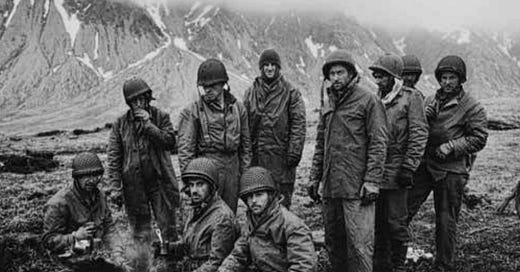It’s been a while since I wrote about the Pacific, and you have lovely Jim to thank for shoving this one in front of me. Bear with me. I know that every single book these days has ‘forgotten’, ‘secret’ or ‘untold’ in the title, BUT with this Second World War battle, it might not be hyperbole. Think Pacific, and you think swamps, sandy beaches or jungle. You don’t think of freezing cold mountain passes, snow, ice and interminable fog…
Fed up American troops photographed on Attu, 14th May 1943 (National Archives and Records Administration)
Attu is the westernmost island in Aleutians, way, way up in the northern Pacific. It sits about a thousand miles off of mainland Alaska. The Russians ‘discovered’ the islands first, and their interest was mainly in the fur trade until 1867, when they were finally bought out by the Americans who then fully controlled the region. The indigenous population, which had been a healthy 30,000 prior to outside intervention in the Aleutians, had been decimated by the Second World War.
The Aleutians are just about the last place you’d want to fight. Semi-frozen, waterlogged, broken up by 3000ft mountains, even getting there was a pain. Aircraft were hampered by perennial fog and high winds, and sea approaches were rendered miserable by hidden rocks and impassable coastline. On average, Attu was blanketed in fog, or low-hanging cloud, and saturated by drizzle and snow almost every day of the week. Clear skies? Maybe ten days a year. As for that wind, that routinely reached 100 miles per hour.
And yet the islands had their appeal from a strategy point of view. After Pearl Harbour and Japan’s blitzkrieg across the Pacific at the end of 1941, they were fully aware that they had a limited amount of time to cause serious damage to the United States in the Pacific before she built herself up on a war footing. Once she had, Japan could not win any kind of protracted war. With this in mind, they flung themselves out in the hope of provoking a decisive Pacific battle and destroying the enemy. This strategy was all based on what had worked for them in the Russo-Japanese war some 40 years before, where it worked, and some might describe it as bold. I’ll go with foolhardy to be diplomatic, but idiotic is also on the table.
The Battle of Midway in June 1942 rightly gets the attention, but part of the bigger plan for destroying the US Pacific Fleet also included distracting American attention away from Midway with air strikes on the Aleutian Islands from Japanese aircraft carriers, to be followed up by temporary amphibious landings before they got out of there before winter. The attack fell apart after the Japanese were seriously humbled at Midway, but regardless, they decided to go ahead with occupying the Aleutians anyway. Their motivations for landing in June 1942 were largely psychological by this point; to be able to say that some 1,100 Japanese troops had occupied north American soil.
In the summer of 1942, America still wasn’t ready to oppose this, and the Japanese forces made use of that time. They set up shop in Chichagof Bay and dug in, also putting defences on beaches at Massacre and Sarana Bays and further outposts in various coves. The Japanese got familiar with the terrain, too. As for the conditions, a lot of them came from the northern Japanese island of Hokkaido. Despite the fact that they could have absolutely done with better maps, at times, Attu almost felt like home to some of these men. But just because they had the upper hand at this point, didn’t mean life was fun for the occupation force. For now, the Americans settled for wearing them down, setting up forward bases from the direction of the Alaskan mainland to get closer for future action, and building runways had to put American aircraft within bombing range of Attu. They then bombed the Japanese in the Aleutians and then continuously harassed the terrifyingly long Japanese supply lines. In all, Tokyo sent 35 ships to the islands in the winter of 1942-43. Only 17 made it there in one piece. With an under-strength infantry battalion and some engineers, the Japanese commander on the spot was instructed to begin constructing a garrison for almost 8,000 men, and an airfield, anti-aircraft positions and coastal defences. Ludicrously ambitious given the circumstances. Harassed by the Americans, the garrison only ever reached half strength, and there were no coastal defences. Lacking materials and men, the airfield remained unfinished. Supplies dribbled in, hampered by enemy attacks, an ever tightening blockade and by the wintery conditions, and yet still the Japanese persisted in the Aleutians…
Chichagof Harbour, where the Japanese based their operations on Attu
Keep reading with a 7-day free trial
Subscribe to Alex Churchill’s HistoryStack to keep reading this post and get 7 days of free access to the full post archives.





